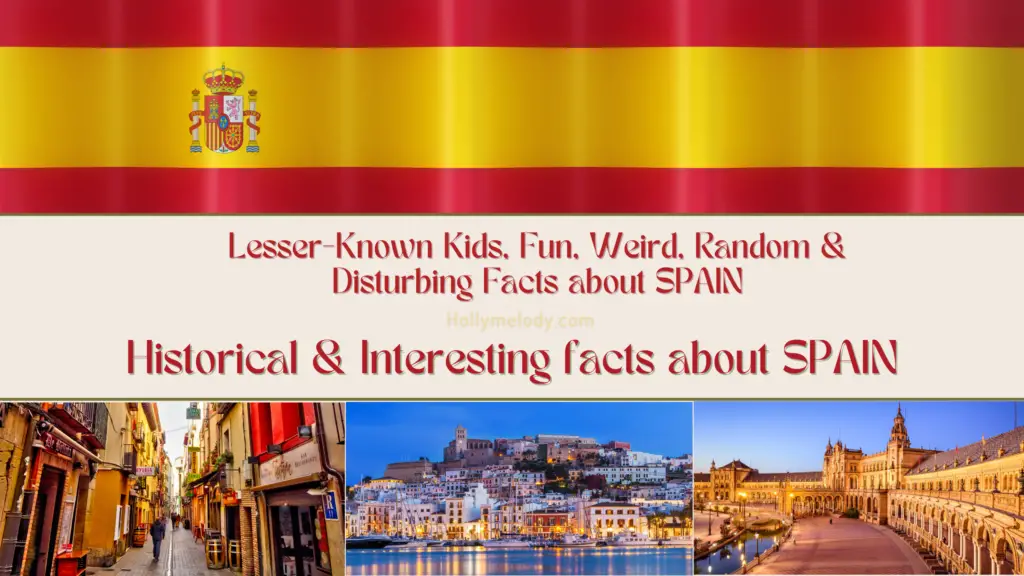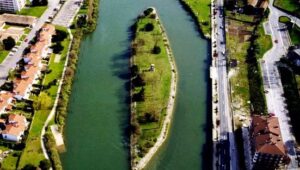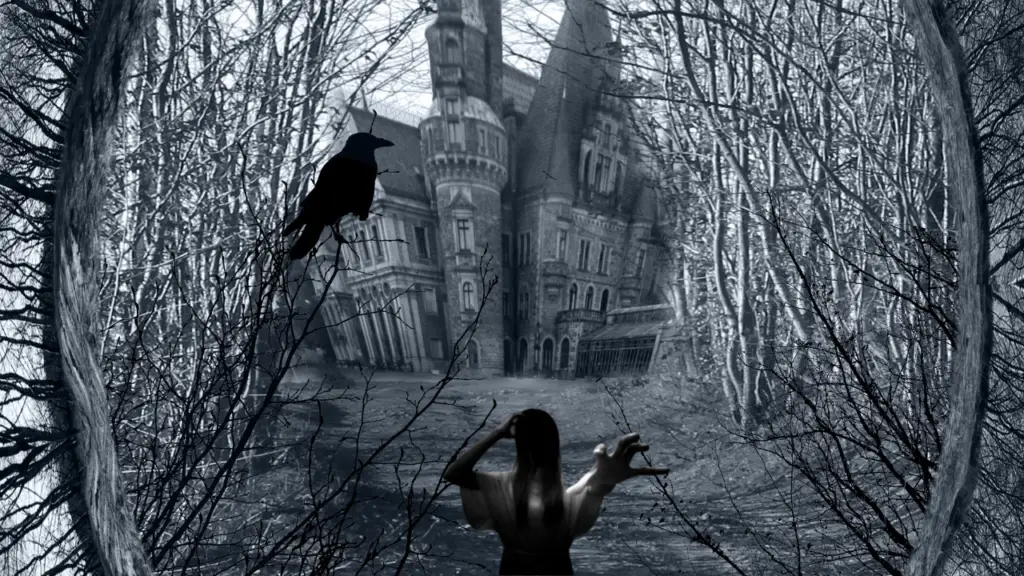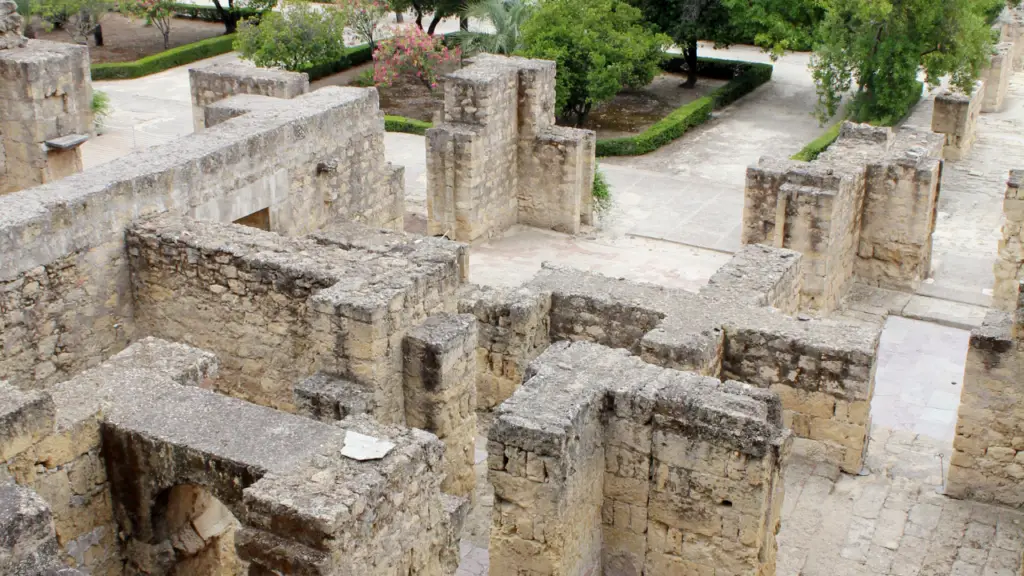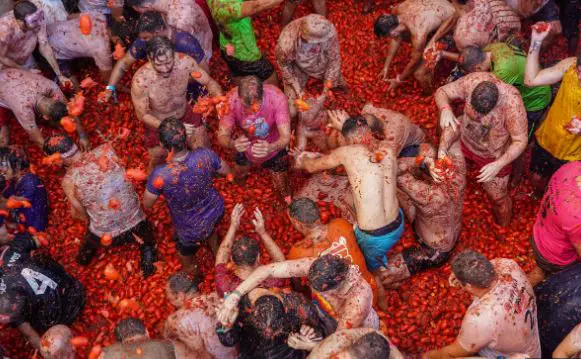Lesser-Known Kids, Fun, Weird, Random & Disturbing Facts about SPAIN | Historical & Interesting facts about SPAIN

- By
- Aparna Patel
- |
- 24 Feb, 2023
- |
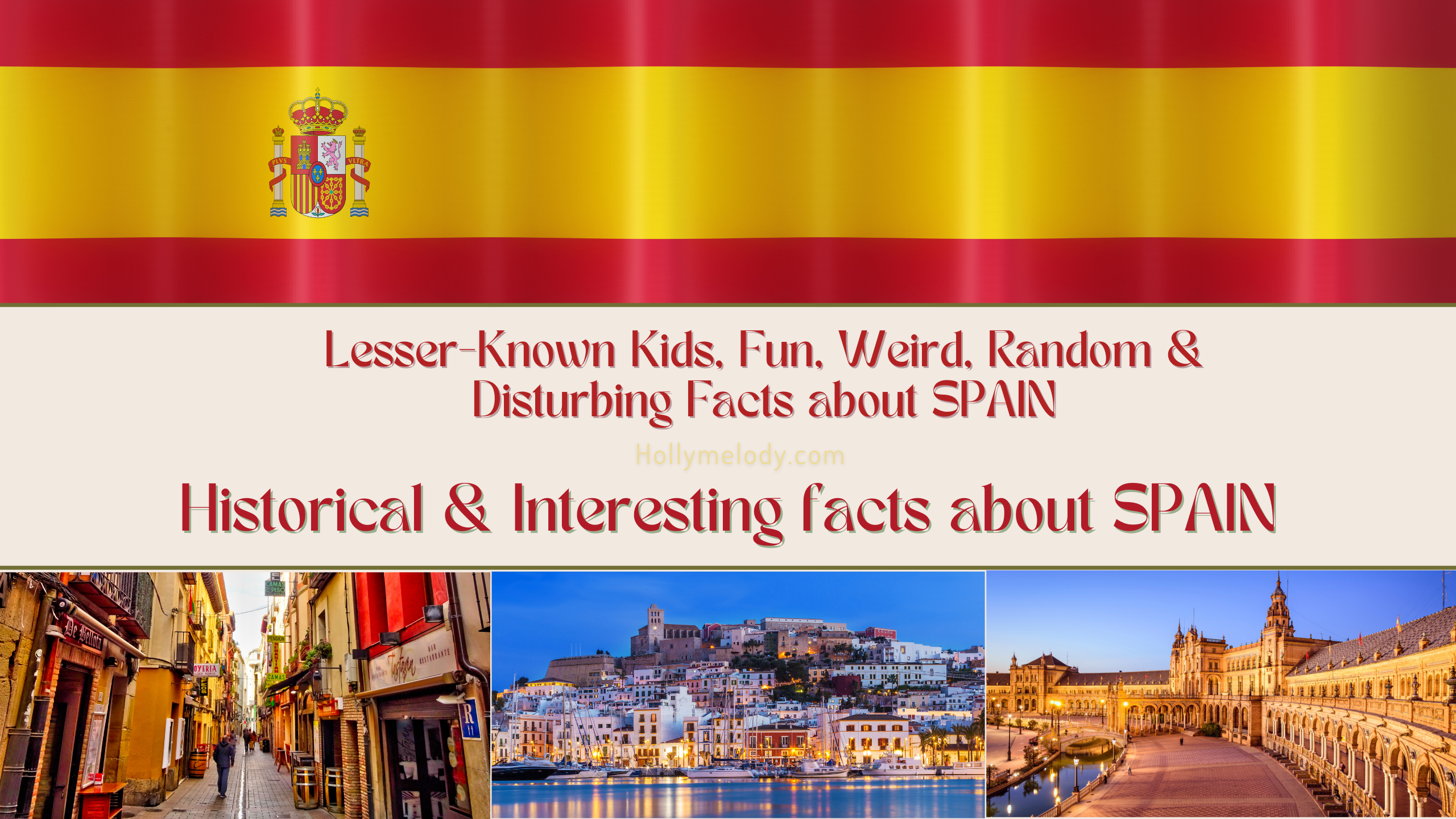
Are you looking for lesser-known facts about Spain? Here is a collection of interesting and fun facts about Spain which You’ve Never Heard Before as well as you can also read general information about Spain such as culture, history, government rule, etc.
Facts about SPAIN
Spain is the second largest country in Western Europe, just behind France, and the fifth largest country in the whole of Europe. Spain is a democracy formed as a parliamentary government under a constitutional monarchy. Spain is a developed country whose nominal GDP makes it the twelfth largest economy in the world, it has a very high standard of living (20th highest human development index), and as of 2005, it was ranked tenth according to a preference for quality of life index. It is a member of the United Nations, the European Union, NATO, the OECD, and the World Trade Organization. The 674-km Pyrenees mountain separates Spain from France. The language is Spanish.
Table of Contents
A: General Facts About Spain
- Total Population – 4.6 million (4.67 crores) (2018)
- Highest mountain – Teide 3718 m
- Total Area – 505,990 km²
- Largest Lake – Lake Sanabria
- National Day – 12 October
- Currency – Euro
- National Song – “Marcha Real”
- Capital – Madrid
B: Amazing Historical & Interesting Facts About SPAIN For Tourists and Kids
1. Spain is the fourth largest country in Europe and is located on the Iberian Peninsula.
2. According to a United Nations report, Spain will be the oldest country in the world after 2050, when 40 percent of the population will be over 60 years of age. Spain ranks fourth with Australia in terms of the average life age of citizens. People live an average of 82.8 years of age. India comes at number 125 in this case.
3. In Spain, 40 percent of the businesses started in the last ten years have been started by women.
4. In the 11th century, the whole of Spain was ruled by Muslims. From 1238, many small Christian states started a war with Muslims and liberated most of Spain from Muslims within a few decades.
5. The country has a rich history, with influences from the Romans, Visigoths, and Moors.
6. Spain is the birthplace of famous artists such as Pablo Picasso and Salvador Dali.
7. The highest mountain is 3,718 meters above sea level, there are more than 1000 mountains of such height in the Himalayas.
8. Most Dangerous Routes in The World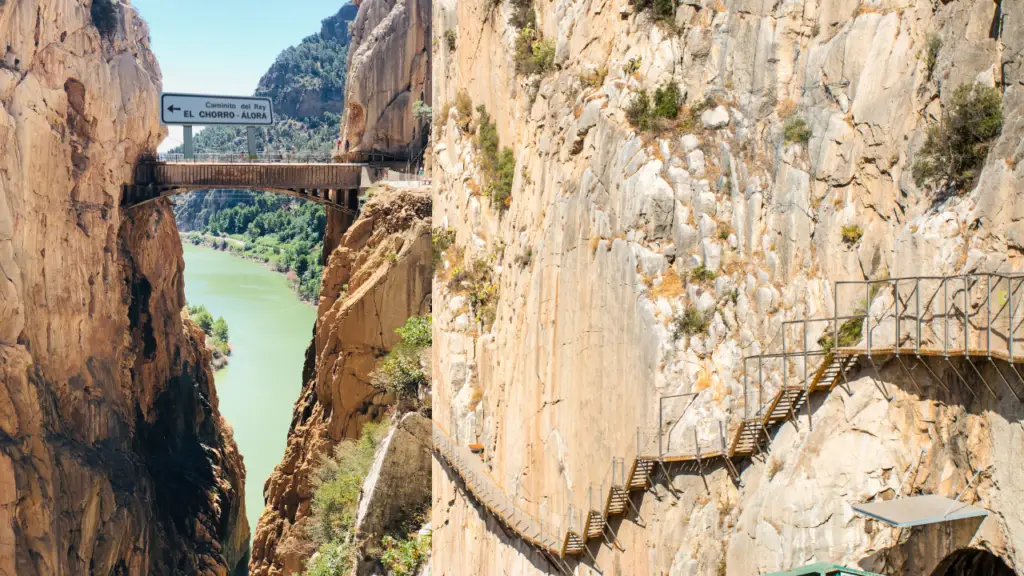
The 110-year-old ‘El Caminito del Rey’ route in the southern region of Spain is considered one of the most dangerous routes in the world. It is also known as ‘King’s Path-Way’. It was built in the year 1905. This dangerous route was designed for laborers working in hydroelectric power plants. However, this road was closed in the year 2000, as two people fell and died.
9. Spanish cuisine is famous around the world, with dishes like paella, tapas, and gazpacho.
10. The architecture of Spain is quite artistic and impressive. The buildings, magnificent churches, forts, monuments, and statues represent the culture of Spain. Antonio Gody is a famous Spanish architect. Flamenco music and dance are world-famous, inventing the flamenco guitar in Spain.
11. Flamenco, a passionate and emotional form of dance, originated in southern Spain.
12. Spain’s bullfight, tomato festival, dishes ‘paella’ and ‘tortilla’, and wine are very popular. But in reality, Spain is known for its art and culture. Some of the world-famous Spanish personalities in the world of art – are Diaga Veláquez, Francisco de Goya, Pablo Picasso, Juan Myro, Salvador Dali, etc.
13. The Running of the Bulls, or “Encierro,” is a famous event held annually in Pamplona during the San Fermin festival.
14. Spain’s tourism industry has grown in the last 4 decades and today it is the largest in the world after the USA. Spain is traditionally an agricultural country. The main products are cereals, vegetables, and fruits. Coal, lignite, iron, uranium, gypsum, tungsten, copper, lead, etc. are natural resources of Spain. Industries include chemicals, machine tools, and shipbuilding.
15. Spain was one of the world’s global empires, with colonies in the Americas, Africa, and Asia.
16. The Alhambra, a palace and fortress complex located in Granada, is one of the most famous and well-preserved examples of Moorish architecture.
17. Tourists can now take a trip to Mars
Holiday website Trip Advisor has created an artificial planet on Earth for those who wish to visit Mars. An artificial planet resembling Mars has been built in the caves of northern Spain. The artificial Mars is at an elevation of 196 feet above the earth and has a 1.4 km long cave. It is claimed that the atmosphere will be exactly like Mars in the cave. Its first trial has been done.
The agency has opened it for tourists. According to the company, the three-day fare is around $7000(Rs 4,80,000). If you want to go on an exciting journey then this journey will prove to be memorable. David Ceballos, CEO of Astroland, the company that built it, says we are working closely with Trip Advisor. I am very happy to be associated with the project because investing in space technology is also like an innovation.
18. The Sagrada Familia, a large basilica in Barcelona, is one of the most famous works of Spanish architect Antoni Gaudi.
C: You do not know these UNIQUE facts about the SPAIN
Here are some unique facts about Spain that you may not have known:
- Spain has more World Heritage sites recognized by UNESCO than any other country, with 48 in total.
- The Spanish language is the second most spoken language in the world, after Mandarin Chinese.
- The Royal Palace of Madrid, the official residence of the Spanish Royal Family, is one of the largest palaces in Europe.
- The Park Guell in Barcelona is another famous work of Antoni Gaudi, featuring colorful mosaics and sculptures set against a stunning cityscape.
- Spain is the world’s largest producer of olive oil, with most of it coming from Andalusia.
- The traditional Spanish siesta, a midday nap taken to escape the heat, is still practiced in many parts of the country.
- The country has a rich maritime history, with famous explorers like Christopher Columbus setting sail from Spanish ports to discover the New World.
- Spain is known for its lively festivals and traditions, such as Semana Santa (Holy Week) and Las Fallas in Valencia.
- The Camino de Santiago, a network of ancient pilgrimage routes leading to the city of Santiago de Compostela, is a popular destination for tourists and spiritual seekers alike.
19. Spain is Most Healthiest Country
The people of Spain are the most healthy. In a recent report by Bloomberg, Spain was considered the healthiest country in the world. Researchers have attributed this to the food habits of the people. They believe that people eat less fat and carbohydrate food, so they are healthier.
The reason why the Spanish people are healthy is the Mediterranean diet. Most people in European countries take the Mediterranean diet. This is also the reason Spain is the healthiest country.
The Spaniards include olive oil and nuts in their meals. Apart from this, starchy items like bread, rice, peeled potatoes, fruits-vegetables, whole grains, and dry fruits are also included in this diet.
Experts also consider the Mediterranean diet to be superior to the low-fat diet. Taking this diet also reduces the risk of breast cancer, heart attack, and brain stroke to a great extent. This can prevent obesity. Let me tell you that the world’s best olive oil is produced in Spain.
20. Sexy Plants to Protect Crops
Just think that a plant attracts insects by creating sexual attraction in harmful insects and then kills them.
It may sound strange, but scientists in Spain have proved they can produce genetic chemicals called pheromones by making genetic changes in plants. Pheromones are the same chemical materials that female worms extract to attract male insects.
The purpose of this new invention is to protect the plants from insects which are very expensive in the market. Through this technique ‘sexy plants’ will be developed. Although pheromones are already being used to protect plants, it is prepared in the laboratory at a very high cost.
21. An Island That Changes its Country Every Six Months
There is a dispute between many countries of the world about the border, while there are two countries of the world who have wisely ended the years-old rivalry and made a compromise that surprises everyone. We are talking about France and Spain. The two countries have entered into an agreement under which both exchange an island at intervals every six months.
Between Spain and France, there is an island named Pheasant. The island is located on the Bidasoa River separating Spain and France.
The specialty of Pheasant Island, with an area of 300 square meters, is that Spain holds the right for six months on this island, and then France holds it for the next six months. This tradition has been going on between the two countries for the last 350 years.
Pheasant is a man-made island that is entirely uninhabited. Being in the middle of the border between the two countries, it is considered to be neutral territory.
In 1659, to end the war between Spain and France, there was a Peace Treaty on this island, which is called the Treaty of Pyrenees.
The treaty was concluded with a royal wedding, in which King Louis XIV of France married the daughter of King Philip IV of Spain. During this time it was decided that both countries would have equal rights on this island. The island remains under Spain’s authority from 1 February to 31 July. After this, it goes to the authority of France.
22. Spain is a leading producer of wine, with regions like Rioja and Ribera del Duero producing some of the world’s finest wines.
23. Most Haunted House in Spain
There are hundreds of ghost buildings all over the world, about which many stories are also heard. One such building in Spain is called Haunted House. The story of this house is very scary. Let us tell you that this haunted house is known as Cortijo Jurado.
This house was bought and rebuilt by Malaga, one of the wealthiest families in Andalusia, Spain. It is said that this sinister house was bought with the plan of making a grand agricultural enterprise. The story of Casa Encantada begins in 1850. Since then, the shadows were seen moving around in this mysterious house. People say that serious crimes and torture have taken place inside the house because this scary house was built a long time ago. The building became known as Spain’s scariest mansion for its spooky and extraordinary activities.
However, the story behind Casa Encantada has been going on since the Heredia family. It is believed that these families along with other rich families used to kidnap girls 18 to 21 years of age. After which the victims were raped and murdered and buried in the mansion. But no one could prove that the Heredia family had a hand in the crime. Now, every night, there are shouting voices from the haunted house which are said to be the same girls and they shout for justice.
24. Spain is Europe’s second-largest country with an area of 5, 5, 990 square kilometers.
25. According to the census 2019, the estimated population of Spain is 46,434,343
26. To marry in Spain, your age should be 16 years.
27. In the case of the average age of citizens (life expectancy), Spain comes fourth with Australia. Here people have an average age of 82.8 years. India comes in 125th place in this case.
D: Unknown Facts about the SPAIN?
Here are some less well-known facts about Spain:
- The Spanish government is a parliamentary constitutional monarchy, with King Felipe VI serving as the current head of state.
- The country is home to the largest solar power plant in Europe, the Andasol Solar Power Station.
- The Palace of Charles V in Granada, built by the Holy Roman Emperor Charles V, is an example of Renaissance architecture and is located within the Alhambra complex.
- Spain has a number of unique regional dialects, with some areas having their own distinct languages, such as Catalan and Basque.
- The city of Toledo, located in central Spain, has a rich history and is known for its well-preserved medieval architecture and production of swords.
- Spain was the host country for the 1992 Summer Olympics in Barcelona, which saw the construction of several iconic sports venues such as the Palau Sant Jordi.
- The country is known for its sandy beaches and clear waters, with popular tourist destinations such as the Costa del Sol and the Balearic Islands.
- Spain has a diverse landscape, with mountainous regions, rolling plains, and arid deserts, as well as a number of national parks and protected areas.
- The Spanish football (soccer) league, La Liga, is one of the most followed and competitive leagues in the world, with famous clubs like Barcelona and Real Madrid.
- The country has a rich cultural heritage, with traditions such as bullfighting, traditional folk music, and religious processions still being practiced in some regions.
28. 40 percent of businesses started in Spain in the last ten years have been started by women.
29. Football is Spain’s most popular sport, this country won the FIFA World Cup for the first time in 2010.
30. Spain’s highest mountain is 3,718 meters high above sea level.
31. The number of Sea beaches in Spain is more than 8 thousand, to be naked in public places is not illegal in Spain.
32. Being a member of the European Union, Spain has been using the Euro as a currency since 1999.
33. Spain’s national sport is football.
34. The Rio Tinto River of Spain is so polluted, it is impossible for aquatic organisms to flourish. In the last 5000 years, it has made it so much more polluted because of mining.
35. In Spain, the divorce rate is much lower than in other western countries. Here only 5% of the children live with unmarried parents.
36. Spain is the first country in Europe, which declared smoking illegal in public places.
37. More than 90% of Spanish people believe in Roman Catholicism as the branch of Christianity.
38. About five million people were killed in the Spanish Civil war War between 1936 and 1939.
39. In the 11th century, the whole of Spain was ruled by Muslims. From 1238 several small Christian states joined together to start a war with Muslims, and within a few decades, most of Spain’s territory was free from the Muslims.
40. In the year 1502, the Spanish government issued orders to all Muslims to become Christians, who did not consider this order, they were fired from the country.
41. Muslims and Spain
Islam originated in Spain in 711 AD during the reign of the Arabian Bani Umayyah. Spain remained under Muslim rule until 1492 AD. After that, there were no Muslims or any mosques left. Islam was spreading rapidly in 711 AD.
42. Grand Mosque of Granada, Spain's only mosque
Prayer has begun in a new mosque in the Spanish city of Granada. A mosque has been built in Spain for the first time since the end of Muslim rule 500 years ago. In Spain, Spanish warriors conquered the Iberia peninsula and ended 800 years of Muslim rule. The mosque took 22 years to build and cost about 4.5 million dollars. Libya, UAE, and Morocco have given money to build the mosque.
43. Spain began using the euro as its main currency in 1999. The circulation of coins and paper notes began in 2002.
44. The cost of living in Spain is very high. People living in Spain often spend more on their living than they spend on education
45. Hockey has been part of the Olympics since 1908, but the World Cup of Hockey was first held in Spain in 1971.
46. Madinat-al-Zahra: The Most Beautiful City in The World
There is no doubt that it was the most beautiful city in the world in its era. This city, full of monuments and attractions, was located eight kilometers away from Córdoba in the province of Andalusia, Spain. And it is also a history that The history of this beautiful city is only 70 years.
We are talking about the mythical Medina Azahara, whose Arabic name was Madina-al-Zahra, ‘Shining City’.
The territories of Spain and North Africa at that time were ruled by Arab Muslims. Prince Khalifa Abdurrahman III of Al Andalus (now the Andalusia province of Spain) settled his capital in 936, west of Córdoba, on the banks of the Guadalquivir River.
- The city was built ten years
The city was named Madina-al-Zahra. This city was built within ten years. In 945, the Khalifa court also came here. - Unprecedented wealth was spent to build this new capital. According to some sources, ten thousand workers worked in the construction of the city. 6000 stones were planted daily. 1500 donkeys and mules were used to carry goods.
- The best craftsmen of that era were employed in carving and neatly made the walls, columns, and streets of the city.
- This city came back into existence when the excavation took place in 1911. This magical city started to shine again.
- According to an estimate, only 11 percent of the city of that period has been revealed. In the year 2018, UNESCO declared it a World Heritage Site.
47. Tomato Battle
In Spain, there is a festival called ‘Tomato battle’, in which people throw tomatoes at each other. La Tomatina is a very big and famous festival in Spain and is considered to be the biggest food fight in the world. It is held every August, and people throw more than 150,000 tomatoes every year.
Tomato Fight is the most popular festival. Approximately 250,000 pounds of tomatoes are used in it. During the festival, people fiercely attack each other with tomatoes. People from all over the world are involved
- This festival is celebrated in Spain every year on the last Wednesday of August.
- People from all corners of the world attend this festival.
- Due to their number in millions, the ticket system has now been started.
- In the year 2002, it was declared as the Festivity of International Tourist Interest.
That’s how it started
It started in 1945 when some youths were protesting in the Spanish city. When the police proceeded to stop them, the youth attacked them by picking vegetables and fruits from the nearby vegetable shops. Since then, ‘La Tomatina’ started being celebrated as a food fight.
48. Unique National Anthem
The national anthem of this country played like the marching tune of the military. Later some words were added to it but since 1970 there has been no word in the national anthem of Spain. Since then, only the tune is played in the national anthem.
49. The Village that divided the New World into two parts
There was a time when a large part of the world was ruled by the British. But even then, there was a large part of the world. Where other European countries ruled, not the British. In the medieval period, the European country Spain
ruled a large part of the world. Especially on the American continent. Except for today’s America and Canada, Spain ruled over the rest of the American continent. Spanish is spoken more or less throughout South America except for one country and the name of this country is Brazil. Brazil is a country in Latin America. Which was a colony of Portugal. The rest of South America was part of the Kingdom of Spain.
The fate of Brazil and the rest of the American country was decided in a small village. The village lies in the Valladolid province of present-day Spain. The name of this village is Tordesillas. In 1494 there was an agreement between Spain and Portugal. The two countries had divided the new world.
Now the village of Tordesias has become a small town. It is situated on the banks of the River Douro. Historians say that this city was a small village in the medieval period. There were many important routes around it, which is why the kings of Portugal and Spain chose this place for such an important settlement.
E: Kids, Fun, Random Facts about SPAIN
Here are some fun and random facts about Spain for kids:
- Spain is famous for its churros, a type of fried dough pastry that is often served with hot chocolate for breakfast.
- The national animal of Spain is the bull, which is celebrated in festivals like the Running of the Bulls.
- Spain is one of the largest producers of oranges and lemons in the world, and these fruits are used in many traditional Spanish dishes.
- The country is home to several amusement parks, including PortAventura near Barcelona and Terra Mitica in Alicante.
- Spain is famous for its fiestas, or parties, which often include music, dancing, and parades.
- The country has a long coastline, with many popular beaches like the Playa de las Catedrales and the Playa de los Muertos.
- Spain is home to some of the tallest and fastest roller coasters in Europe, like the Dragon Khan at PortAventura.
- The country has a rich tradition of folk music, with regional styles like Flamenco and Jota originating in Spain.
- Spain is famous for its castles, with famous examples like the Castillo de Coca and the Castillo de Loarre.
- Spain has a Mediterranean climate, with warm summers and mild winters, making it a popular tourist destination all year round.
50. Bartolomé Esteban Murillo, World Famous Artist
Bartolomé Esteban Murillo was born in December 1617 in the city of Saville, Spain. The most famous painting of
Murillo is ‘Two Women at a Window’.
This painting he made in about 1655. Bartolomé Esteban Murillo has created many such paintings that are still remembered today.
Murillo’s childhood was spent in poverty. His father was a barber and surgeon. He learned painting from his uncle. Whatever paintings he used to make in childhood, he used to sell at the fair. He did the work of selling paintings at the fair till his youth.
51. Bullfighting
Spain is very famous for bullfighting. Artists are also injured during this time. Bullfighting in Spain is famous all over the world. Recently a bullfighting man died. This was the first death inside the enclosure during the Battle of the Bulls in Spain in this century. Since this death, this event has once again come under controversy.
People in Spain are demanding a ban on this bloody game. In Spain, about 2000 bullfight is organized every year. However, due to the imposition of place restrictions in Spain, its number is decreasing. This traditional event in Spain has now become the identity of this country.
F: Historical Facts About SPAIN
Today’s Spain is a democracy organized as a parliamentary government under a constitutional monarchy. Due to its position, this country has been having external influences since time immemorial. In contrast, Spain also had
influence over many other regions, especially in the modern era when Spain had become a global empire.
As a result, today there are approximately 500 million Spanish-speaking people, making Spanish the second most spoken language in the world. The Spanish Empire is one of the earliest and largest empires in the world. Its colonies were located in Europe, North and South America, Africa, Asia, and Oceania.
The Iberian Peninsula became part of the Roman Empire, known as ‘Hispania’. During the early medieval era, it came under the rule of Germany but was then conquered by the Muslim invaders. After a long and irregular war, the Christian states of the north gradually drove out Muslim rule from Spain.
Spain became a great colonizing kingdom with Columbus’s discovery of America by Spain in 1412.
Spain became the most powerful nation in Europe during the 16th century with much of its wealth in the US, but after the defeat of the Spanish Armada at the hands of England in 1588, Spain was reduced to a small peninsular power. In 1939 General Franco was a dictatorship over a politically and economically damaged and weak country.
After the death of Franco in 1975, a constitutional monarchy was established.
G: Random, Weird Facts about the SPAIN?
Sure, here are some random and weird facts about Spain:
- The Spanish town of Bunyol holds an annual tomato fight called La Tomatina, where participants throw overripe tomatoes at each other in the streets.
- In Galicia, there is a tradition of planting a tree on the ground upside down as a symbol of good luck.
- The oldest restaurant in the world, Botin, is located in Madrid and has been serving traditional Spanish dishes since 1725.
- The Spanish island of Majorca is home to the Cave of Drach, a series of interconnected caves with underground lakes and stunning rock formations.
- In Spain, it is traditional to eat 12 grapes at midnight on New Year’s Eve, one for each chime of the clock, to bring good luck for the coming year.
- The “Running of the Bulls” festival in Pamplona is a controversial event that involves bullfighters running through the streets while being chased by bulls.
- Spain is home to a number of underground catacombs, including the Catacombs of San Francisco in Granada and the Catacombs of San Jose in Seville.
- The country has a number of unusual museums, such as the Museum of Illusions in Barcelona and the International Museum of the Barbed Wire in Pamplona.
- The Spanish city of Barcelona has a park called Parc Guell, which features colorful mosaics and sculptures created by the famous architect Antoni Gaudi.
- Spain is famous for its flamenco dance, which originated in the Andalusian region of the country and is known for its passionate and fiery style.
H: Important historical events related to SPAIN country
20 July 1031: Henry I, the successor of Robert II, takes over as King of Spain.
1492: All Jews were expelled from the European country Spain.
04 May 1493: Pope Alexander VI divided the continent of America between Portugal and Spain. Pope Alexander VI divided the continent of America between two countries, Portugal and Spain.
15 March 1493: Christopher Columbus returns to Spain after his world tour.
15 December 1516: After the discovery of the southern American country of Argentina, the first Spanish faction arrived at this place. Thus Spain’s authority over this country began.
14 November 1533: Spanish explorers locate Ecuador, located in the northwest of South America, and include it in their colony.
30 May 1539: The explorer Hernando de Soto discovers Florida.
16 January 1556: Spain’s Emperor Carrell chooses his son Philip II as his successor.
1581: British Parliament declares Roman Catholicism illegal.
17 January 1595: King Henry IV of France declares war against Spain.
18 July 1630: Spain’s troops occupy Italy’s Mantua province.
1701 – 1714: Battle between Britain, Netherlands, and Austria vs. France and Spain in 1701 – 1714.
1739: England declares war on Spain.
1809: Ecuador gained independence from Spain.
1811: Seven provinces of Venezuela declared independence from the rule of Spain.
1922: Revolt in Morocco against Spain.
I: Important Date in SPAIN History
Here are some of the important dates in Spain’s history:
- 1469: The marriage of Ferdinand II of Aragon and Isabella I of Castile, united the two largest kingdoms of Spain and led to the creation of a unified Spanish state.
- 1492: Columbus sets sail from Spain on his first voyage to the Americas, opening up a new era of exploration and colonization.
- 1588: The defeat of the Spanish Armada by England, marked the end of Spain’s naval dominance and the beginning of its decline as a major world power.
- 1605: The publication of Miguel de Cervantes’ “Don Quixote,” widely considered to be the first modern novel and a masterpiece of Spanish literature.
- 1808-1814: The Peninsular War, a conflict between Spain and France that saw Spanish resistance against Napoleon’s forces and helped to spread the ideals of liberalism and nationalism.
- 1868: The First Spanish Republic is declared, marking the beginning of a turbulent period of political instability and social upheaval.
- 1931: The Second Spanish Republic is established after King Alfonso XIII abdicates, leading to a period of political and economic reforms.
- 1936-1939: The Spanish Civil War, a conflict between the Republican government and Nationalist forces led by General Francisco Franco, which resulted in Franco’s victory and the establishment of a dictatorship.
- 1975: The death of Franco and the transition to a democratic government, marking the beginning of Spain’s modern era and its integration into the European Union.
- 2004: Spain joins the eurozone, adopting the euro as its official currency and further integrating into the European economic and political systems.
Read More:
Historical Facts About Finland
Lesser-Known Facts About Germany
J: Tourism in Spain
Spain’s tourism industry has grown in the last 4 decades and today it is the largest in the world after the USA. Spain is traditionally an agricultural country. The main products here are cereals, vegetables, and fruits. Coal, lignite, iron, uranium, gypsum, tungsten, copper, lead, etc. are natural resources of Spain. Industries include chemicals, machine tools, and shipbuilding. The beautiful city and lifestyle are enough to attract tourists. These 5 cities in Spain are places to hang out.
1. Barcelona
One of the most favorite cities in Spain is Barcelona City, where there is a boom of new dishes, fashion, and music throughout the year. The city is especially famous for its football team. The buildings built by the famous architect Antony Gaudi are very beautiful. The Sagrada Church is no less than a wonder. Famous painters Picasso and Miro’s paintings are also the centers of attraction for tourists. The wine is world-famous.
2. Granada
It used to be the most unique city in Spain during the Muslim empire in the pages of history and still exists. Arabic influence can be seen in the culinary arts, architecture, and crafts of the city. Europe’s most beautiful palace Alhambra is also present here. It is also known for its unique weather, snow-capped mountains, and beautiful beaches.
3. Madrid
Madrid, the capital of Spain, is the heart of this country. The fun and frolic nights make it more special. Built in the 17th century, the Plaza de Oquierte, the Plaza de Oriente, the Opera House, and the modern architectural Almudena Church are one of the major scenic spots here.
The world’s largest art gallery Prado is also worth seeing. Madrid is also known as Europe’s greenest capital due to RetiroPark, Casa-de-Campo, and Juan Carlos Park. This city is no less than a paradise for night lovers.
4. Seville
If you are fond of games, then this city is the best place to fulfill this wish because here you can enjoy outdoor games like horse riding, cycling, and hiking. Like Madrid, bullfighting can be enjoyed here too. Festivals-East Week and Feria-the-April in Seville are the famous fairs held in April which the Spaniards celebrate with great pomp.
5. Valencia
Valencia is one of the biggest cities in Spain and is also one of the favorite places for tourists. The Bhusiya-the-Bellas Art Museum here is no less than a surprise for art lovers. In this museum, the arts of artists like El Greco, Goya, and Velazquez are seen.
Read more:
If you know any new things about Albania, then definitely tell through the comments so that other people can read, thanks.
Search Posts
Latest posts
-
5 Mar, 2024
Passing through airport security with autism
-
4 Mar, 2024
How can I do a "broad" search for flights?
-
5 Mar, 2024
How to avoid drinking vodka?
Popular posts
-
5 Mar, 2024
Why prohibit engine braking?
